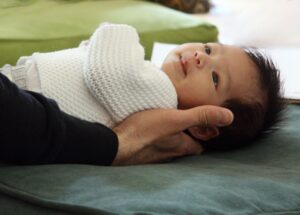
Craniosacral Therapy
A newborn CST session can minimize or eliminate the repercussions of difficult births and help ensure good health for well babies. All babies should receive newborn Craniosacral evaluations and treatments as soon as possible after birth. Children should continue to receive pediatric CST periodically throughout childhood as they grow and develop.
A Typical Pediatric CST Session
Children rest fully clothed on a massage table or in my lap or their parent’s lap. Sometimes children sit, crawl, walk, stand or play with toys on the floor during the treatment. They don’t need to hold still.
I adapt my techniques to the attention span and needs of the child. I monitor the craniosacral rhythm with my hands. I conduct other gentle assessments and correct the sources of pain and dysfunction using gentle manipulative techniques.
Sometimes children release emotions or cry during treatments, but the techniques do not hurt babies and children. Seldom does the pressure exceed five grams (the weight of a nickel). The work is very gentle.
CST treatment sets the stage for the body to most efficiently use its own power to heal. Most children find the sessions to be deeply relaxing. Babies and children will often sleep for a longer stretch than usual after a session.
Virtual Appointments
I make virtual appointments with people who want to learn how to help their infants at home. In these visits I take a health history, I listen to babies, I look at babies and I establish treatment goals virtually.
Because I have been teaching infant CST for many years, I am able to help parents/caregivers apply hands-on techniques and engage in therapeutic activities with their babies at home. Some of those techniques I guide through observation, coaching and conversation. Others I demonstrate remotely with a baby doll.
Virtual visits are only available for pre and newly-crawling infants. Once you have made an appointment for this service, you’ll receive an email from me outlining next steps for our online connection.
After a virtual visit appointment I send a detailed email to parents/caregivers outlining the health history, treatment goals, my observations, my recommendations and instructions for therapeutic home care activities and any documents/videos that support the care plan.
We also have the option of recording the appointment so you can access it later.
Getting Born
During the birth process, the baby’s head molds to fit through the parental pelvis. It is normal for the cranial bones to override each other. After birth, these overrides and other accommodations in the baby’s skull should not persist. If they do not correct themselves, they can interfere with proper cranial nerve function leading to colic, breathing, swallowing, digestive or sensory-motor impairments and more. Sometimes babies are injured in the birth process. The injuries may be both physical and emotional. CST can address these injuries as well as the effects of lack of normal mobility in utero, precipitous or prolonged labor, vacuum extraction, forceps or cesarean birth.
Surgical Birth
Cesarean birth can be harder on babies than we imagine. Cesarean-born babies have lower Apgar scores, more respiratory distress, more abnormal neurological exams, and more abnormal Craniosacral evaluations. They have more chronic middle ear infections and other problems throughout childhood. The birth process is more abrupt and potentially more frightening than vaginal birth. Surgically born infants have fewer quiet alert periods right after birth and have less opportunity to share bonding time with their parents who may be unconscious or recovering in another room. CST can effectively address all of these things.
Craniosacral Therapy Can Help:
- Fussy, hard to soothe babies
- Babies who seem uncomfortable in their bodies
- Babies who have digestive or elimination difficulties
- Reflux
- Colic
- Spitting up
- Breastfeeding problems
- Difficult latching
- Latch problems that contribute to sore nipples for moms
- Babies who favor turning their heads to one side
- Babies who favor one breast or position for nursing
- Babies who seem overly sensitive
- Babies who hate tummy time
- Teething babies
- Non-sleeping babies
- Children who have mobility issues
- Children who have sensory issues
- Children who have vision issues
I work with individuals and families of all structures, cultures, and faiths. I am LGBTQIA+ affirming.
Schedule an Appointment Get On the Mailing List Send Carol an Email